AMD Launches Mobile Kaveri APUs
by Jarred Walton on June 4, 2014 12:01 AM ESTAMD Kaveri FX-7600P System/CPU Performance Preview
After the briefing, we were given a chance to benchmark a prototype Kaveri notebook for a few hours. That wasn't enough to run our full suite of laptop benchmarks, and battery testing in particular is something we couldn't perform. I did run some quick simulations of battery life; however, the prototype systems are optimized more for performance rather than power, so the results weren't really meaningful. We'll have to wait for retail laptops with Kaveri APUs before we can really see what sort of battery life to expect, but AMD claims there should be a decent jump in mobility compared to Richland.
The test systems were more of a proof of concept rather than anything you could actually sell. The keyboard was okay if a little mushy, but the touchpad in particular I found a bit lacking, and build quality was mediocre as well. The screens at least were good quality 1080p 15.6" touchscreen panels, and that was enough to get us benchmarking. I snapped a few pictures of the laptop that you can see above. In terms of other core specs, the laptop had 8GB of DDR3-1866 RAM and a Samsung M.2 256GB SSD.
For our purposes here, we're including the AMD Kaveri Prototype, AMD Trinity Prototype, and AMD Kabini Prototype laptops as a starting point. For retail laptops, we have the MSI GX60 with Richland A10-5750M APU (but only a single 8GB SO-DIMM, unfortunately), the Sony VAIO Pro 13 (i5-4200U), and the Acer V7-482PG (i7-4500U + GT 750M). The Acer is the only laptop equipped with a discrete GPU, so we wanted to see how Kaveri stacks up against such a system. You can compare additional results against Kaveri in Mobile Bench, of course.
Again, these numbers are only preliminary – the drivers for the GPU were slightly older (without Mantle support enabled yet), and there were occasions of odd behavior where other editors had scores that didn't match up with our results until after a reboot. We were not able to run each benchmark multiple times, so most of these results are from a single run. AMD is keen to talk about the GPU improvements with Kaveri, but I also wanted to see what has happened on the CPU side, so we'll start with our CPU/system benchmarks.
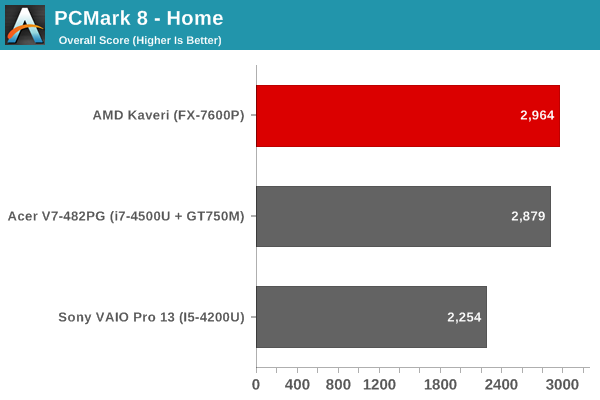
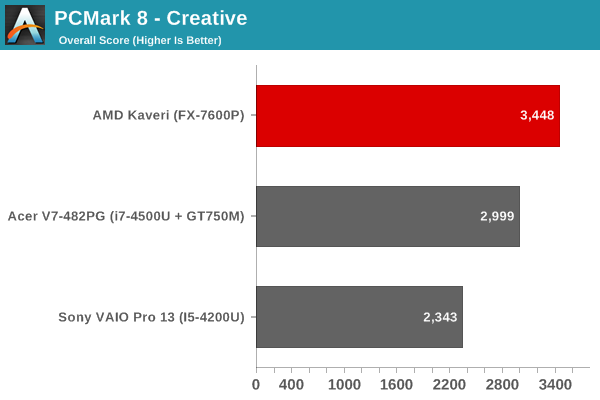

We don't have results for PCMark 8 for many of the systems, and the VAIO Pro 13 seems to be underperforming for some reason, but otherwise we get a pretty good idea of where things fall in terms of overall performance. Note that PCMark 8 is now OpenCL accelerated, which can improve performance quite a bit on AMD APUs. The result is that AMD actually takes the lead in the Home and Creative suites, but without more time benchmarking the system I wouldn't try to draw too many conclusions. Storage subsystem performance can still have an enormous impact on PCMark results, and the V7-482PG has to get by with an SSD caching solution. The VAIO Pro 13 on the other hand just seems to score a bit lower than I'd expect, so again take these scores with a grain of salt.
Moving on to other benchmarks, I also ran PCMark 7 as it doesn't have any OpenCL acceleration and will provide a better view of traditional application performance. Hopefully we'll continue to see improvements in the use of OpenCL (GPU) acceleration and over time PCMark 8 scores will be more indicative of real-world performance, but right now there are plenty of situations where having a GPU does very little for performance.

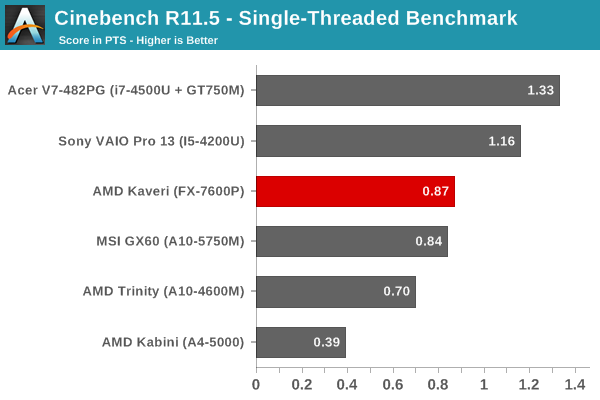
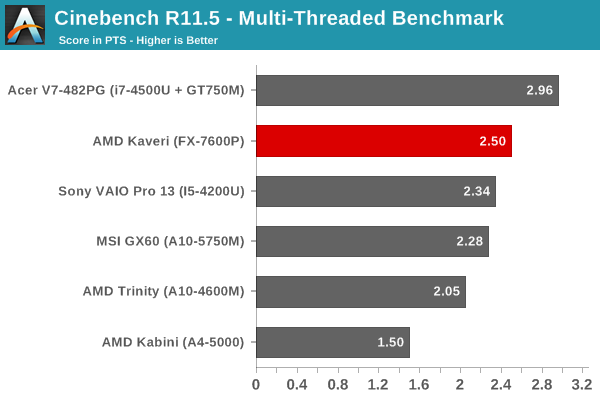
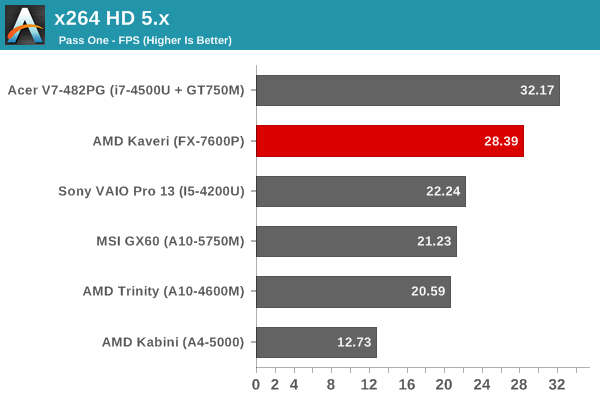
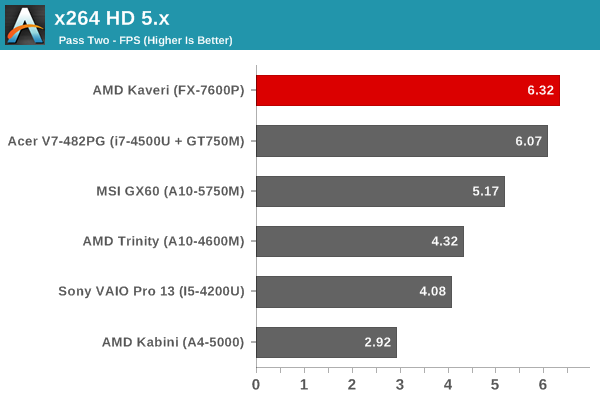
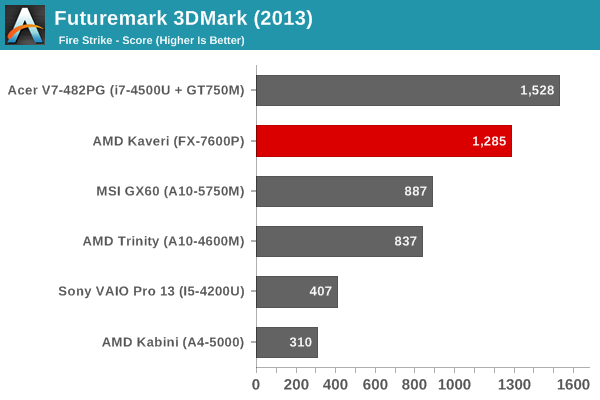
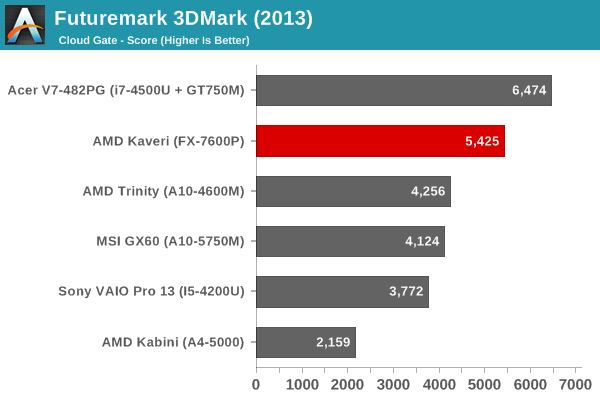

Somewhat surprisingly, Kaveri actually takes the lead in the very demanding second pass of the x264 HD 5.0 encoding test. Granted, we're looking at a 35W APU vs. 15W ULV CPU, and Intel's 37W quad-core parts would certainly retake the lead (and cost quite a bit more), but at least Kaveri is showing some real improvements over Richland in these tests. As noted above, PCMark 7 doesn't have any OpenCL optimizations so the gap between AMD and Intel is a bit wider.
Moving to the 3DMark results, Kaveri shows an impressive increase in performance over the Trinity/Richland GPU, which is expected. Intel's iGPU – particularly in the ULV system shown here – just doesn't stand a chance. While we are potentially TDP limited for the ULV Intel parts in graphics tests, my experience is that 3DMark hits the GPU much more than the CPU, so the GPU gets the lion's share of the TDP. I'll try to run some tests on other Haswell systems using the iGPU to verify the above results, but outside of the HD 5000 and Iris parts, I wouldn't expect Intel's iGPU to be too much faster than what we're seeing here.
Overall, an Intel CPU with a discrete GPU is still faster than Kaveri in most areas, and a quad-core i7-4702QM would really distance itself from AMD's Kaveri…but the quad-core i7 CPUs tend to start at around $350, so there's not much point in discussing that comparison. My personal feeling is that unless you're really pushing a laptop hard, most of the modern CPUs/APUs are plenty fast. I wouldn't want a Kabini APU, but Trinity/Richland, Ivy Bridge, Kaveri, and Haswell are all going to be fine for everyday use.
The more important element for me with a laptop (or desktop) is that I simply can't stand using conventional hard drives for the primary storage device any longer. Given the choice between an AMD Kaveri APU with a 256GB SSD (the Crucial MX100 is sure looking nice!) and pretty much any other laptop that has pure HDD storage, it's a no brainer for me. In fact, laptop manufacturers would do their customers a great service if they took the cost savings of AMD's APU vs. Intel's CPU and put that into a decent SSD solution rather than chasing the lowest possible price!


_thumb.jpg)
_thumb.jpg)
_thumb.jpg)
_thumb.jpg)
_thumb.jpg)








125 Comments
View All Comments
CoronaL - Wednesday, June 4, 2014 - link
lol me toomax1001 - Wednesday, June 4, 2014 - link
I would love to see a nicely spec ultrabook with this APU and $800-$1k price point that can do decent gaming.AnnonymousCoward - Wednesday, June 4, 2014 - link
It'd be fun to throw a GTX 760 in the mix, just to see where we're at.CoronaL - Wednesday, June 4, 2014 - link
Wonder if they will pair that up with a cheap 250x mobile version for some X-fire gaming on laptop. I bet that would beef up the graphics a fair bit. IMO the cpu part is pretty respectable trading blows with the i7 and i5 for the most part, which AMD usually gets trounced in.azazel1024 - Wednesday, June 4, 2014 - link
Well it does look a lot better than Richland and price might be a big driver in making these interesting (I see no prices?), but 19w Kaveri versus 15w Haswell ULT...the 15w Haswell ULT, depending on the turbo performance of the 19w Kaveri part looks to run roughly as fast to a very sizeable 20-30% lead in CPU performance and with the GPU cut down to roughly half performance between core and clock reduction...the Haswell ULT is likely to be on par graphically +/-10%. In a lower power consumption package...and if the Kaveri has turboing issues or the GPU is thermally constrained in this package it could be a much more significant lead.The 15w Kaveri doesn't look like it would be on the performance map at all (<<<50% of the performance of Haswell ULT). The standard voltage parts actually look the most interesting, especially if the price is moderate. That would probably allow you to make a decent performing machine (70-90% of an Intel's CPU performance) with a very nice iGPU for a rather low price point (assuming the FX-7600p is very price competitive to the Intel Haswell SV dual core parts).
azazel1024 - Wednesday, June 4, 2014 - link
I guess I missed something with the Intel chips in regard to the TDP. My experience is vastly different. Most Intel chips, both desktop and mobile, don't seem to come close to hitting max TDP under full CPU load. Especially in the desktop space I see something like my i5-3570 with a TDP of 77w is hitting around a 35w delta between idle and full load based on wall plug data, considering losses from the power supply and assuming a fairly low (CPU) idle number, thats only in the area of 30-40w total power consumption. That isn't simply under load, the processor is clocked up to 4.2GHz single core and 4GHz all 4 cores turbo. That isn't a max burn situation where every single itty bitty capacitor and transistor is loaded like Intel does in their TDP tests, but that is under 100% sustained CPU load across all 4 cores.From what I have seen with Ivy Bridge testing (which ain't Haswell I'll admit) a fully loaded i5-3317u seems to only use in the area of 8-10w with both cores fully loaded max turbos 100% CPU load. Its the GPU that uses a huge whack of power, >12w under max load and turbos.
I'd assume Haswell is pretty close there, at least with the CPU, since the turbo core speed is the same, same lithography, very similar architecture. So I doubt a ULT Haswell is using more than 10w under max CPU load and turbos. Its the GPU that is going to be the power hog.
No idea what AMD is capable of on these, but we know they are using a less energy efficient process, so I'd assume/guess that their CPU is probably below the cap under max CPU load, but it might be much closer, maybe in the 12-15w range under max turbo, meaning GPU load is going to cause the CPU to scale pretty far back, even on the 19w chips.
worm - Wednesday, June 4, 2014 - link
It seems like any benchmarks of the Ax-7xxxP should be against an ix-4xxxM, not MQ, like over at Tom's, and the 7xxx, should be against the ix-4xxxU, at approximately the closest price point. That leaves plenty to choose from, in laptops in the market. Hopefully we can get that data so a real comparison can be made. I hope we are just waiting on OEMs to release their Kaveri laptops, in both 19w, and 35w forms, to make it worthwhile?JarredWalton - Wednesday, June 4, 2014 - link
I am actually testing the first dual-core standard voltage Haswell laptop right now, so I'll have that data added to Bench in the next week.meacupla - Wednesday, June 4, 2014 - link
still waiting on A6-7600K.I know it's a desktop CPU, but c'mon, it's been four months since Febuary and I don't even see it in stock at newegg.
MLSCrow - Wednesday, June 4, 2014 - link
Why are they comparing Kaveri to the 15W ULV i7? Simple, because it's a more fair comparison for multiple reasons:A) That i7 is a dual core with hyperthreading (4 threads). Kaveri is a dual module with modular multithreading (4 threads). An AMD module is what you compare to a single Intel Core with hyperthreading. That is the fair comparison. It wouldn't be fair to compare a dual core vs a quad core now would it?
B) Although the Intel chip is still more expensive than the Kaveri, it is much more closely priced than the quad core version. Price ranges should always be taken into consideration when comparing offerings of like-capabilities from different manufacturers.